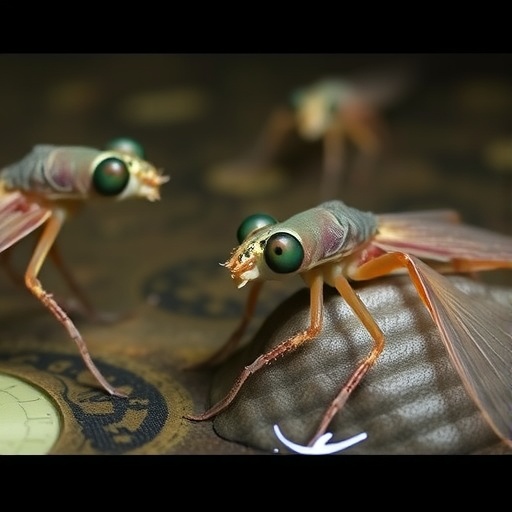In a remarkable discovery that sheds light on the complexities of aquatic ecosystems, researchers have documented an aberrant specimen of the Mystus vittatus, commonly known as the striped catfish, hailing from the wild populations of the Gomti River in Uttar Pradesh, India. This revelation emerges from a meticulously conducted integrative study, unraveling new insights into the species’ conservation status. The significance of this finding cannot be overstated, as it highlights critical ecological concerns that could have far-reaching consequences for not only the species itself but also the broader health of the riverine environment.
Historically, Mystus vittatus has been a focal point for ichthyologists due to its ecological role and economic importance in the region. The species has long been cherished in local culinary traditions and is often found in markets owing to its favorable taste and texture. Nonetheless, the recent identification of an aberrant variety challenges our understanding of its genetic diversity and adaptability. The implications of these findings serve as a clarion call for heightened conservation measures, as the genetic anomalies may signal environmental stressors affecting the species.
The research methodology employed in this study was both comprehensive and innovative, integrating morphological assessments with genetic analyses. The researchers utilized advanced techniques such as DNA barcoding, which entails sequencing specific regions of the genome to identify variations among individual specimens. This methodological rigor allowed the researchers to discern subtle differences among catfish populations, ultimately leading to the identification of the aberrant specimen, which deviates from established morphological norms.
A comprehensive literature review underscores that the Gomti River has faced various anthropogenic pressures, ranging from pollution to habitat alteration. These factors have precipitated a decline in aquatic biodiversity, raising alarms among ecologists and conservationists alike. The observed aberration in Mystus vittatus is emblematic of the broader ecological dysfunction within the Gomti River system. Researchers believe that disturbances in the habitat and water quality could be contributing to these genetic changes, thereby impacting the resiliency of the population and its ability to survive in the long run.
Moreover, the altered phenotype of the aberrant Mystus vittatus raises important questions regarding its reproductive viability and success in natural environments. In a field that increasingly recognizes the role of genetic diversity in resilience to environmental changes, the presence of atypical individuals could indicate reduced genetic health and adaptability among populations. This finding warrants urgent attention from river management authorities and conservation groups, prompting discussions on potential interventions to restore ecological balance.
The study also highlights the need for long-term monitoring of the Gomti River and its fish populations. Regular assessments could provide valuable data on population dynamics, helping to identify trends associated with environmental changes or human impacts over time. Such data could prove essential for informed decision-making and for developing strategies aimed at conserving the aquatic biodiversity of the region.
Further complicating the conservation narrative is the socio-economic fabric of the local communities reliant on the Gomti River. Fishing practices and reliance on local fisheries for food and income create a dual-edged sword; while there is a pressing need for sustainable practices, immediate strategies must consider economic realities faced by fishers. A balanced approach that integrates ecological preservation with community support is paramount to mitigating risks to the species and their habitats.
In conclusion, the first report of aberrant Mystus vittatus from the Gomti River encapsulates a pivotal moment in conservation science, bringing to light the intricate interplay between environmental change and species health. As we grapple with the existential threats posed to biodiversity, this case serves as a reminder of our shared responsibility to protect the natural world and to acknowledge the intricate relationships that bind ecosystems together.
The journey from discovery to publication represents a significant effort by the scientific community to bring attention to these urgent issues. It underscores the importance of collaboration among researchers, policymakers, and local communities to foster an integrated approach to conservation. As awareness grows, so too does the recognition that every species, no matter how seemingly ordinary, plays a critical role in the tapestry of life.
The future of Mystus vittatus and the health of the Gomti River hangs in the balance, serving as a barometer for the conservation challenges we face globally. Through continued research, advocacy, and action, we have the opportunity to chart a new course, one that aligns the needs of biodiversity with those of human communities. This singular discovery may very well mark the beginning of a revitalized conservation narrative for the Gomti River, one that we must all partake in ensuring a thriving future for generations to come.
Subject of Research: Aberrant Mystus vittatus from the Gomti River, India
Article Title: Correction to: First report of aberrant Mystus vittatus (Bloch, 1794) from wild population in the Gomti River, Uttar Pradesh, India, based on integrative approach: a new conservation concern.
Article References:
Sahu, A., Singh, M. Correction to: First report of aberrant Mystus vittatus (Bloch, 1794) from wild population in the Gomti River, Uttar Pradesh, India, based on integrative approach: a new conservation concern.
Environ Monit Assess 197, 1271 (2025). https://doi.org/10.1007/s10661-025-14727-7
Image Credits: AI Generated
DOI:
Keywords: Mystus vittatus, aberration, conservation, Gomti River, ecological impact




